 Hello, gentle readers, and welcome to the RPG Reload, the weekly feature where we never met a Gibson we couldn’t hack. Each week, we take a look at an RPG from the App Store’s past to see how it’s hanging in the here and now. It’s a chance to revisit some old favorites, reflect on their position in the iOS RPG tapestry, or just to take a deeper dive than reviews typically allow for. I try to present a balanced plate of RPGs from week to week, but that’s a job that gets more difficult the further into this we go. So, if you’ve noticed that I’ve missed a game that you’d really like to see, please let me know by commenting below, tweeting to @RPGReload, or by dropping in on the Official RPG Reload Club thread in the TouchArcade forums. I schedule pretty far in advance, so I can’t promise your suggestion will appear soon, but it will go on the list.
Hello, gentle readers, and welcome to the RPG Reload, the weekly feature where we never met a Gibson we couldn’t hack. Each week, we take a look at an RPG from the App Store’s past to see how it’s hanging in the here and now. It’s a chance to revisit some old favorites, reflect on their position in the iOS RPG tapestry, or just to take a deeper dive than reviews typically allow for. I try to present a balanced plate of RPGs from week to week, but that’s a job that gets more difficult the further into this we go. So, if you’ve noticed that I’ve missed a game that you’d really like to see, please let me know by commenting below, tweeting to @RPGReload, or by dropping in on the Official RPG Reload Club thread in the TouchArcade forums. I schedule pretty far in advance, so I can’t promise your suggestion will appear soon, but it will go on the list.

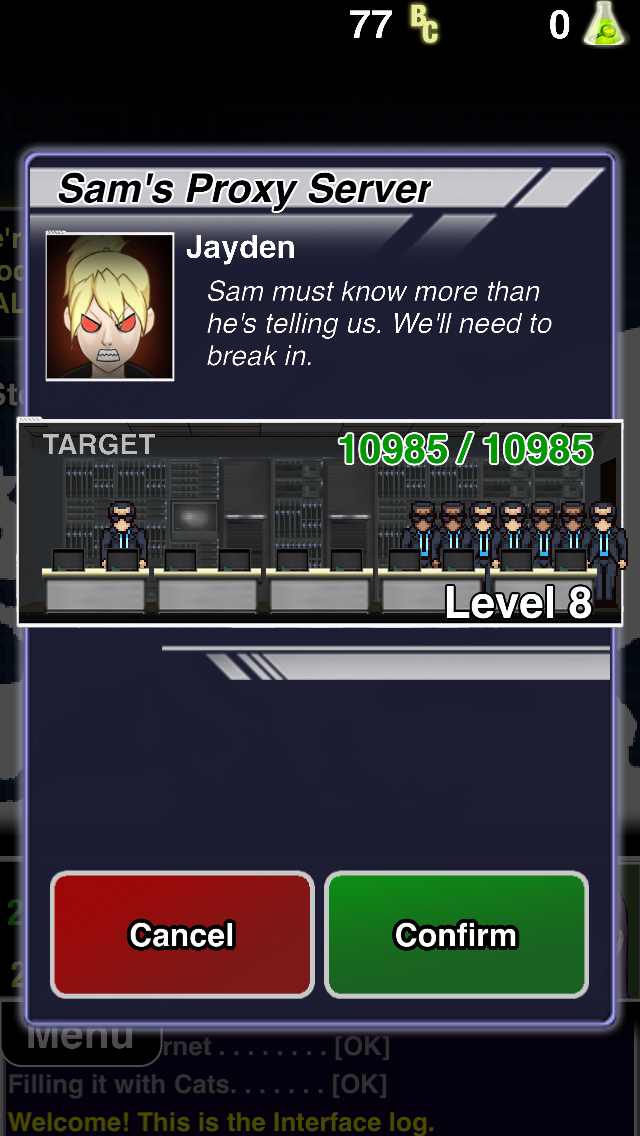
Well, I hope everyone enjoyed their holidays. With the special columns and history feature, it’s been a month since we had a regular old RPG Reload. Before we get under way, I want to take a little time to address the state of the feature, seeing as how it’s a new year and everything. The History Of Handheld RPGs series is almost half-finished, and I suspect once it’s done there will be additional changes in the RPG Reload feature. I’m thinking of doing RPG Reloads every other week and sandwiching Classic Reloads that cover non-RPGs in between. I truly wanted to get Classic Reload going last year, but finding time for it was hard. I’ll make a decision about that come August, but I wouldn’t mind hearing your input, friends. As for the Podcast, we had a technical problem with the December episode about 9th Dawn, and the holidays kept getting in the way of recording the January one on schedule, but I’m happy to say we finally got it done. You can expect that big 9th Dawn/King Cashing episode next week, after which we’ll back to our regular routine. Thanks as always for your patience and support.
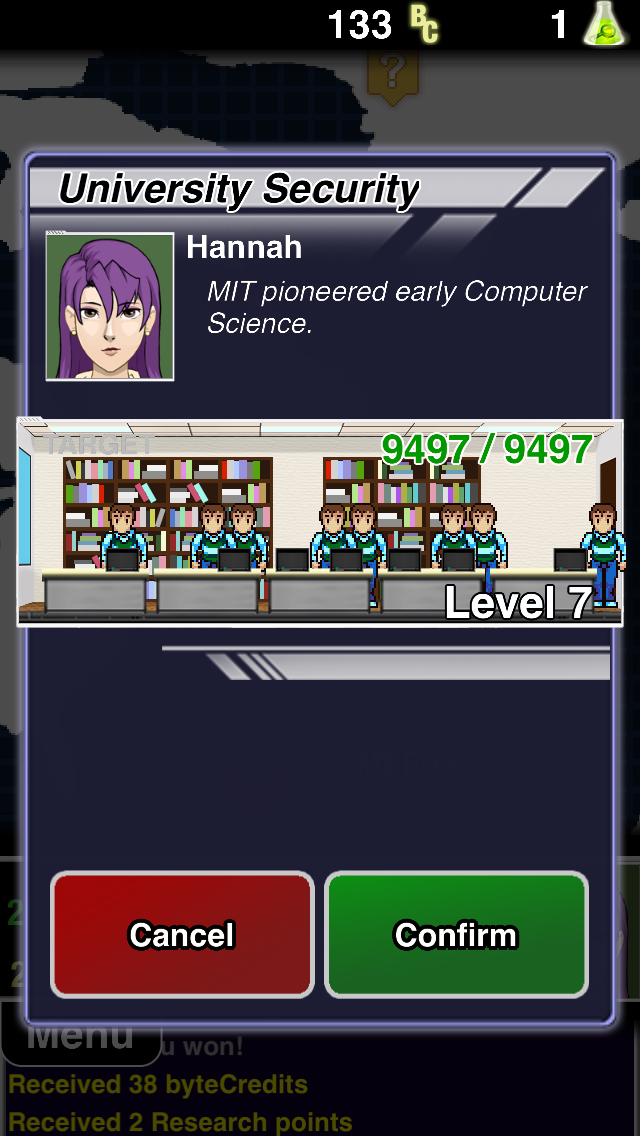 I’ve always had a strange view of Nameless: The Hackers RPG ($7.99). While this could just be my personal experience, I feel like it’s one of those games that just about everyone knows about but nobody seems to remember until they’re reminded. I’m not sure exactly why that’s the case. The game got reasonably good reviews and a pretty strong response from our readers when it launched. I guess in a market that moves as quickly as the mobile market does, it’s easy for a game to get dragged out with the tide fairly fast. The game is on sale frequently, however, which I think keeps the game in people’s periphery. The developer of the game, BoxCat, has yet to follow up Nameless with another game, which probably hasn’t helped. Well, whatever the reasons it dropped off, it’s a good candidate for shining a light on now.
I’ve always had a strange view of Nameless: The Hackers RPG ($7.99). While this could just be my personal experience, I feel like it’s one of those games that just about everyone knows about but nobody seems to remember until they’re reminded. I’m not sure exactly why that’s the case. The game got reasonably good reviews and a pretty strong response from our readers when it launched. I guess in a market that moves as quickly as the mobile market does, it’s easy for a game to get dragged out with the tide fairly fast. The game is on sale frequently, however, which I think keeps the game in people’s periphery. The developer of the game, BoxCat, has yet to follow up Nameless with another game, which probably hasn’t helped. Well, whatever the reasons it dropped off, it’s a good candidate for shining a light on now.
Nameless is an RPG designed specifically for mobile. It’s the first, and so far only, game released by developer BoxCat, a small team of less than five full-time staff that operates out of Los Angeles, California. In a rare case, one of the team members was kind enough to give out a lot of details about the process of developing Nameless, which involved pooling all of the things they liked about the JRPG genre and then deciding which elements were best-suited for mobile and the scope BoxCat had to work within. Due to the way most people play on mobile, the game was designed to work in three-minute chunks, and the interface was built to be fully touch-based to avoid having to mess around with virtual buttons. The hacking theme came out of a desire to differentiate the game from the largely fantasy-themed competition on the App Store. They went with four characters because they felt three wouldn’t be enough for interesting character drama, while more than four would exponentially increase the complexity of the project.
There are a lot of interesting insights on both the design and the marketing of Nameless at BoxCat developer James Liu’s blog on Gamasutra, and I recommend checking it out. Suffice it to say, the team did their homework. I’m not sure if it paid off financially, but at least in terms of game design, they came up with a surprisingly strong rookie effort. Nameless: The Hackers RPG released officially on March 18th, 2013. Since then, the developer has been hard at work on a couple of other projects, including a sequel to Nameless and an airship RPG called Flying Fortress, all while doing an excellent job of keeping Nameless in good fighting shape. Given how thoughtfully-designed Nameless is, I’m interested to see how BoxCat improves with later games.
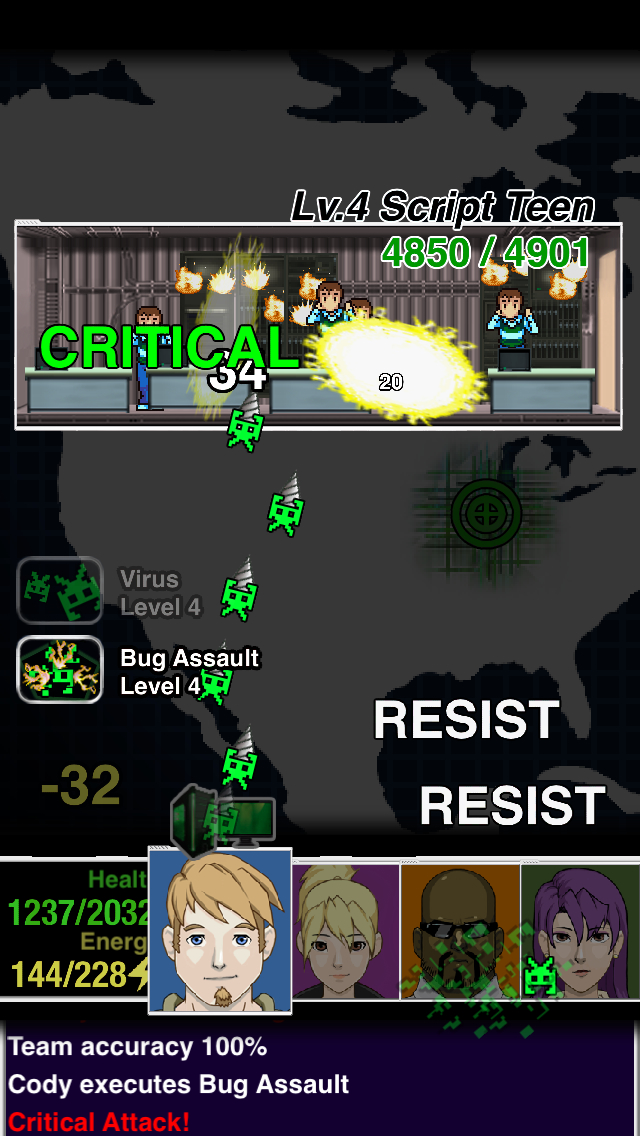 It’s not a hard and fast rule, but I’ve observed that when it comes to smaller-scope mobile RPGs, developers usually focus on one or two main RPG elements while sacrificing in other areas. If I had to nail down those main elements, they would probably be story, character building, exploration, and combat. Nameless doesn’t do much with exploration. The game is a series of battles and story scenes, with both kinds of situations triggered from a world map. It fits the theme well, however, since none of your characters are meant to actually be in the places where events take place. Instead, since they’re hackers, they’re presumably working from the comfort of their own homes. That set-up also gives the game a good excuse to use primarily head portraits to convey the story. The characters have enough facial expressions to get across their feelings, and the developers aren’t above doing silly things like having one character’s window slam the other one for effect.
It’s not a hard and fast rule, but I’ve observed that when it comes to smaller-scope mobile RPGs, developers usually focus on one or two main RPG elements while sacrificing in other areas. If I had to nail down those main elements, they would probably be story, character building, exploration, and combat. Nameless doesn’t do much with exploration. The game is a series of battles and story scenes, with both kinds of situations triggered from a world map. It fits the theme well, however, since none of your characters are meant to actually be in the places where events take place. Instead, since they’re hackers, they’re presumably working from the comfort of their own homes. That set-up also gives the game a good excuse to use primarily head portraits to convey the story. The characters have enough facial expressions to get across their feelings, and the developers aren’t above doing silly things like having one character’s window slam the other one for effect.
The character building aspects are also fairly light, in part thanks to the unusual way the game handles stat progression. You don’t gain experience points from fighting battles. Instead, you earn a currency called byte credits, along with research points, which are sort of a substitute for experience points. If you’re lucky, or the plot dictates it, you’ll also earn a card that gives you various stat boosts based on its rarity and type. There’s a shop that sells a variety of items including new special abilities for your characters, a small assortment of cards, consumable items, and boost items. You can use your byte credits to buy any of these things, but the exact selection is gated by how far you’ve progressed in the story. Once you’ve unlocked a skill, you can use the research points you’ve collected to level it up, though the cap for your skill levels is also typically gated by how far you are in the story. You’ll occasionally earn cards that increase the cap on your skills, but they’re almost never random drops. The same goes for cards that increase the caps on your HP and Energy, which can be increased with byte credits. Unless you intentionally ignore certain things, exactly how your characters progress is going to be similar to anyone else’s, plus or minus the luck element of drawing better versions of cards.

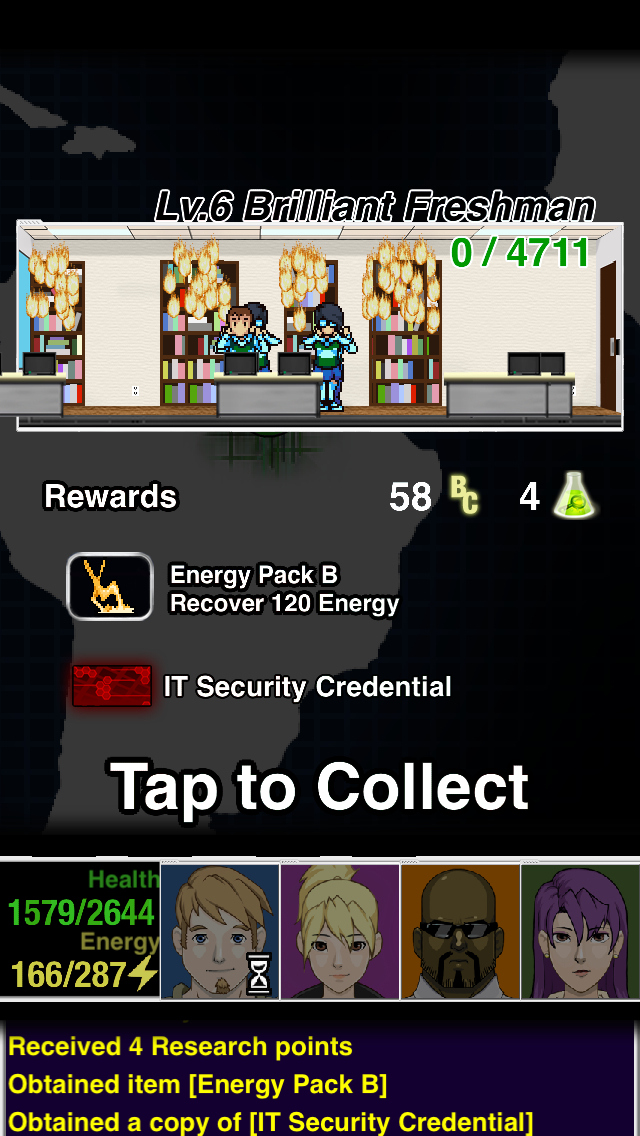
It’s a clever system that ensures you’ll never be too overpowered and allows the game to be relatively sure of what you have in your toolbox. In an ideal world, this can lead to a relatively smooth path through the game for players who make the most of their abilities. In practice, Nameless runs into a few problems. If, for whatever reason, you’re having trouble with a particular battle, there aren’t a lot of options open to you for getting around it. If you have the byte coins to spare, you can load up on boosts and hope they’ll carry you to victory, but if that doesn’t work, the only way you can improve your stats is to try rolling better rarities on your cards. You can spend some byte coins for a random pull that might improve the card or leave you with a worse version, or you can spend research points to make a similar random pull that at least allows you to choose whether you want the new card or not. If a card is at minimum rarity, there’s no harm in spending the byte coins, but beyond that, you’ll almost certainly want to stick to research points. Those come a lot more slowly from fodder battles than the byte coins do, but neither currency flows like water if you’re trying to keep all of your characters completely upgraded.
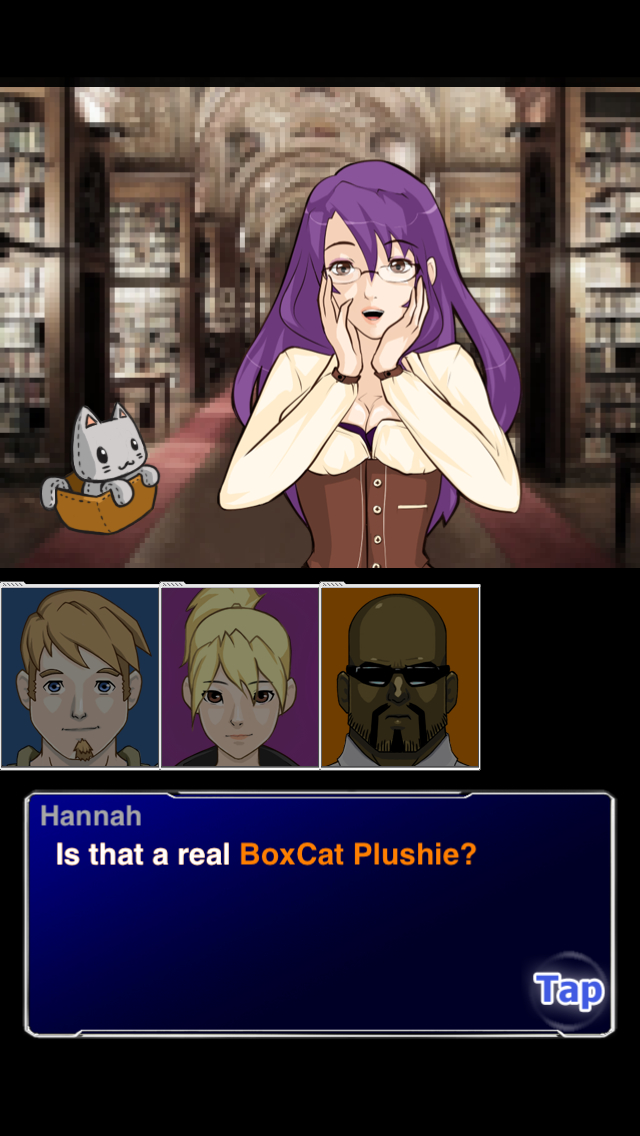 That last conditional is the killer. I think most players will want to keep characters fully upgraded because that’s the way a lot of people play RPGs, but if you give up that notion and only focus on upgrading what is useful to you, the game is a bit smoother in its progression. I think Nameless could be a bit clearer about how its systems work in order to encourage that style of play. The battles are visually busy and while that’s interesting, it also makes it difficult to understand what the consequences of each move are. There’s a system of elemental weaknesses and strengths in the game, for example, but it’s not pronounced, so I think it gets lost behind the computer terminology. This leads to players going at battles inefficiently, and upon failing, heading to the grinding mill, which is a route that does Nameless no favors. It’s one of the root causes behind the complaint I’ve heard that the game is too repetitive, I think.
That last conditional is the killer. I think most players will want to keep characters fully upgraded because that’s the way a lot of people play RPGs, but if you give up that notion and only focus on upgrading what is useful to you, the game is a bit smoother in its progression. I think Nameless could be a bit clearer about how its systems work in order to encourage that style of play. The battles are visually busy and while that’s interesting, it also makes it difficult to understand what the consequences of each move are. There’s a system of elemental weaknesses and strengths in the game, for example, but it’s not pronounced, so I think it gets lost behind the computer terminology. This leads to players going at battles inefficiently, and upon failing, heading to the grinding mill, which is a route that does Nameless no favors. It’s one of the root causes behind the complaint I’ve heard that the game is too repetitive, I think.
The other thing behind that issue is that the game is mainly a series of battles, and if you’re going to pull that off without people’s eyes glazing over, you have to be very careful. The battle system needs a lot of variety, enemies have to change their tactics, new abilities need to change the nature of battles, and so on. Importantly, you also need to avoid having frivolous battles, as even the best system will start to crumble with too many of those. The main battles in Nameless are excellent challenges that, for the most part, force you to use what you have very carefully. The enemies largely draw on the same bag of tricks you do, albeit a few steps ahead of where you’re at, so they can still surprise you now and then. You’ll likely have seen most of the status ailments you can be afflicted with not too far into the game, but the scale of the attacks can ratchet up in unexpected ways. I think if we only look at the mandatory battles in Nameless, its battle system is good enough to sustain the game’s running time.
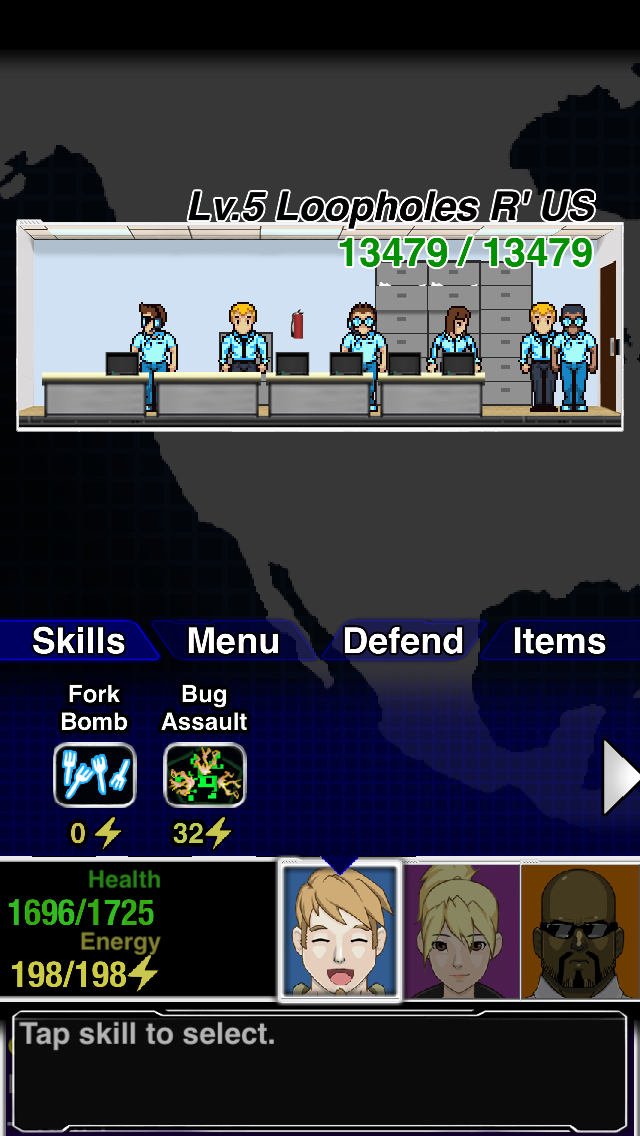 Unfortunately, you’ll almost certainly end up doing a healthy number of side battles, which are typically easy enough that you don’t really have to engage with them very carefully. They will inevitably take a bite out of your HP and Energy stocks, however, to say nothing of occupying your time and attention in less than satisfying ways. Your HP and Energy will restore over time as long as you’re not in battle, but unless you use an item, you will have to wait to get back up to speed. Buying items eats into the profits you’re ostensibly hoping to earn by grinding those battles, so you either end up grinding even more battles, or you close the app and come back in a few minutes when your team will be recharged and ready to go. It’s one of those well-intended ideas that doesn’t quite go the way it was probably intended to go, I think. That said, it does push the player towards digesting the game in smaller bites, which helps curb some of the weariness you might otherwise feel from a constant string of battles.
Unfortunately, you’ll almost certainly end up doing a healthy number of side battles, which are typically easy enough that you don’t really have to engage with them very carefully. They will inevitably take a bite out of your HP and Energy stocks, however, to say nothing of occupying your time and attention in less than satisfying ways. Your HP and Energy will restore over time as long as you’re not in battle, but unless you use an item, you will have to wait to get back up to speed. Buying items eats into the profits you’re ostensibly hoping to earn by grinding those battles, so you either end up grinding even more battles, or you close the app and come back in a few minutes when your team will be recharged and ready to go. It’s one of those well-intended ideas that doesn’t quite go the way it was probably intended to go, I think. That said, it does push the player towards digesting the game in smaller bites, which helps curb some of the weariness you might otherwise feel from a constant string of battles.
Aside from the battles, the other main area of focus in Nameless is in the story and characters. I think it’s quite successful in that regard, presenting an interesting tale with a few surprises that will have you wanting to see what comes next. It also has a good sense of humor about itself, and it’s not shy about making a silly joke or reference now and then. Most of the really wacky stuff is found in side content, keeping the main plot serious enough to get invested in. The characters are a little thin in terms of their personal development, but they bounce off of each other and the main plot well. At least for me, the narrative was the carrot that kept me moving through Nameless, while the other aspects were competent enough that they never impeded that movement.
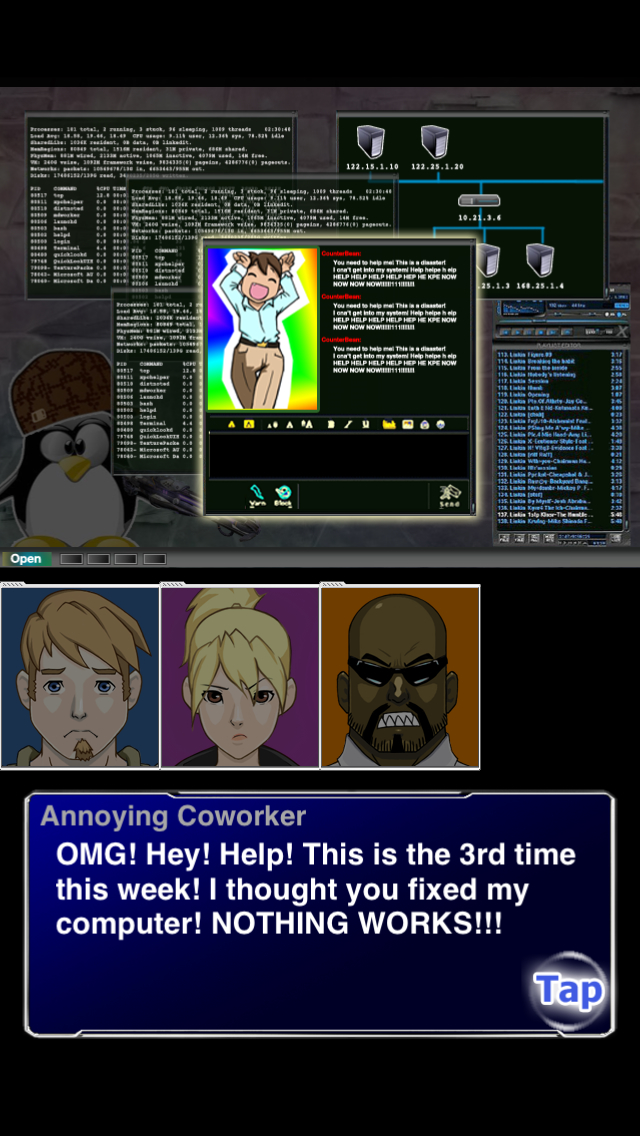 I really like the theme of the game, and it’s still fresh a few years down the road. I’m sure someone who knows the topic well might roll their eyes at some of it, but the terms and situations feel authentic enough for a layperson like me. I also appreciate that it never went too far down the jargon rabbit hole, because I’m sure the temptation was there. For all of my nitpicks about the gameplay, if you take Nameless as the short-burst RPG it was designed to be, it’s hard to find many complaints about it. The presentation is great, the gameplay is engaging and reasonably well-balanced, and the story will keep your attention and even toss in a few laughs. I’m especially impressed with the UI, with the game easily playable with one hand. Everything is straightforward enough for a beginner to cope with while being chewy enough that a veteran ought to enjoy themselves, too.
I really like the theme of the game, and it’s still fresh a few years down the road. I’m sure someone who knows the topic well might roll their eyes at some of it, but the terms and situations feel authentic enough for a layperson like me. I also appreciate that it never went too far down the jargon rabbit hole, because I’m sure the temptation was there. For all of my nitpicks about the gameplay, if you take Nameless as the short-burst RPG it was designed to be, it’s hard to find many complaints about it. The presentation is great, the gameplay is engaging and reasonably well-balanced, and the story will keep your attention and even toss in a few laughs. I’m especially impressed with the UI, with the game easily playable with one hand. Everything is straightforward enough for a beginner to cope with while being chewy enough that a veteran ought to enjoy themselves, too.
As mentioned earlier, BoxCat has taken very good care of this game over the years. It’s received several updates, addressing bugs that have sprung up from new hardware or iOS versions, and making adjustments or additions based on player feedback. They’ve made the game a universal app after launching as iPhone-native, added Game Center support, and even implemented iCloud support. Oh, and more cats. The most recent update came in October of 2015, which fixed some issues with iOS 9 and added the aforementioned Game Center stuff. Because of the care afforded to the game, it plays just as well now as it ever did, if not better. It’s great to see a developer taking good care of their games, especially given their small size and how busy they must be working on upcoming projects.
For a first-time effort from a small studio, Nameless is great. Sure, I can pick holes in it, but I can do that with just about any game. I think it works a little better if you break up its ten or so hours into several gameplay sessions, but while it was designed around three-minute chunks of fun, those chunks are like cookies of JRPG-style deliciousness. You could just eat one or two at a time, and you know eating the whole bag at once will make you sick, but it’s a tempting idea anyway. This was only my second time playing through the game, with my first run being just after it initially released, but I liked it well enough that I’ll probably play it again down the road sometime, perhaps when the sequel releases.
That’s just my take on Nameless, though. What do you all think? Let me know by commenting below, tweeting to @RPGReload, or by posting in the Official RPG Reload Club thread. If you don’t have the game, want to try it, and can’t spare the coin, you might want to keep an eye on that Twitter account over the weekend. Just saying. As for me, I’ll be back next week with another RPG from long, long ago. Beware the wrath of the software keyboard! Thanks for reading!
Next Week’s Reload: Bard’s Tale 2 ($2.99)